美国脑囊虫病治疗指南 2013年
美国神经病学会(AAN)指南
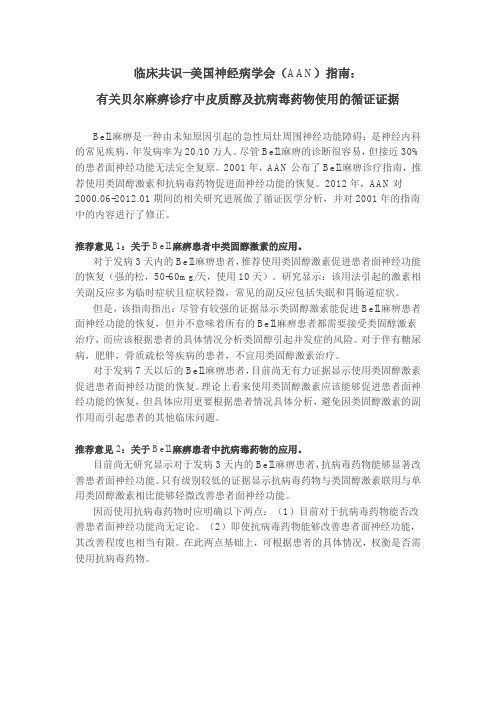
临床共识--美国神经病学会(AAN)指南:有关贝尔麻痹诊疗中皮质醇及抗病毒药物使用的循证证据Bell麻痹是一种由未知原因引起的急性局灶周围神经功能障碍;是神经内科的常见疾病,年发病率为20/10万人。
尽管Bell麻痹的诊断很容易,但接近30%的患者面神经功能无法完全复原。
2001年,AAN公布了Bell麻痹诊疗指南,推荐使用类固醇激素和抗病毒药物促进面神经功能的恢复。
2012年,AAN对2000.06-2012.01期间的相关研究进展做了循证医学分析,并对2001年的指南中的内容进行了修正。
推荐意见1:关于Bell麻痹患者中类固醇激素的应用。
对于发病3天内的Bell麻痹患者,推荐使用类固醇激素促进患者面神经功能的恢复(强的松,50-60mg/天,使用10天)。
研究显示:该用法引起的激素相关副反应多为临时症状且症状轻微,常见的副反应包括失眠和胃肠道症状。
但是,该指南指出:尽管有较强的证据显示类固醇激素能促进Bell麻痹患者面神经功能的恢复,但并不意味着所有的Bell麻痹患者都需要接受类固醇激素治疗,而应该根据患者的具体情况分析类固醇引起并发症的风险。
对于伴有糖尿病,肥胖,骨质疏松等疾病的患者,不宜用类固醇激素治疗。
对于发病7天以后的Bell麻痹患者,目前尚无有力证据显示使用类固醇激素促进患者面神经功能的恢复。
理论上看来使用类固醇激素应该能够促进患者面神经功能的恢复,但具体应用更要根据患者情况具体分析,避免因类固醇激素的副作用而引起患者的其他临床问题。
推荐意见2:关于Bell麻痹患者中抗病毒药物的应用。
目前尚无研究显示对于发病3天内的Bell麻痹患者,抗病毒药物能够显著改善患者面神经功能。
只有级别较低的证据显示抗病毒药物与类固醇激素联用与单用类固醇激素相比能够轻微改善患者面神经功能。
因而使用抗病毒药物时应明确以下两点:(1)目前对于抗病毒药物能否改善患者面神经功能尚无定论。
(2)即使抗病毒药物能够改善患者面神经功能,其改善程度也相当有限。
美国ACS TQIP TBI管理实践指南

美国ACS TQIP TBI管理实践指南简介颅脑外伤(TBI)往往给公共卫生和社会经济带来严重后果。
在美国,据统计每年急诊就诊或在院的患者中约有250万与TBI有关,其中约有50000多人死于TBI,有相当比例的TBI患者遭受暂时或永久性残疾。
据估计,TBI 每年对美国经济造成的负担超过760亿美元,且花费在残疾及劳动力丧失保障方面的费用要远高于急救治疗费用。
关于急性TBI的管理,目前设计严密的对照研究数据甚少。
虽然基于循证医学的TBI管理指南已经出版,但是这些指南所依赖的临床研究的质量限制了指南的推荐强度和使用范围。
《TQIP脑外伤管理实践指南》采用了目前已有的、最可靠的证据,对于研究证据不足的某些方面,则采用专家们一致公认的经验和观点。
GCS评分的应用要点:①格拉斯哥昏迷评分(GCS)是评估意识障碍程度的可靠工具;②对GCS评分必须进行规范的评估和记录;③必须记录每一项的评分(睁眼、言语、运动);④GSC总分(3-15)对患者的轻重分类及预后评价意义重大。
四十年前Teasdale和Jennett首先发明了GCS评分,GCS评分能由轻到重全方位评估患者意识障碍;现在GCS评分在临床和科研中被国际广泛采用。
GCS评分的目的在于评估三个不同项目的反应:睁眼反应(E)、言语反应(V)、运动反应(M)(表1)。
对于个别患者,所有项目及总分都要作出具体报告,例如E4V4M5,GCS总分13。
GCS总分(3-15)与分组比较水平密切相关,并且为患者的分类及预后提供了一个有用手段/方式。
轻型脑外伤≥13分,中型脑外伤9-12分,重型脑外伤≤8分。
若GCS评分被麻醉原因或者其他混淆因素影响致不能评估的,该原因应当被如实记录。
虽然经常这么做,但是1分不应当被记录,因为真正的1分之差是无法评估的,伴随时间变化的GCS评分曲线将会有助于对早期变化的监测。
既要对患者自然状态下的反应进行评估,又要对其在刺激状态下的反应作出评估。
美国卒中或短暂性脑缺血发作防治指南(中文版)

【关键词】美国心脏协会科学声明;脑缺血;短暂性脑缺血发作;卒中;卒中预防
在美国,卒中是导致死亡和残疾的一个重要原 因。短暂性脑缺血发作(transient ischemic attack, TIA)或卒中存活者代表着随后卒中风险增高的一 个人群。在每年发生的795 000例卒中患者中,约1/4 为复发性事件。TIA的真实患病率很难估计,因为 有相当多的TIA患者并未到医疗机构就诊…。基 于针对复发性卒中决定因素的流行病学资料和临床 试验结果,我们能够提出循证推荐来降低卒中风险。 值得注意的是,许多现有数据来自包含有限数量的 老年人、女性和多种族人群的临床研究,还需要进一 步研究,以证实这些研究结果的普遍适用性。
万方数据
国匣堕鱼簦近苤壶垫!!生!旦笙!!鲞筮!塑蜒』堡咝螋!Q熊』g婴!盟垫!!:地:12:奠!:1
·3·
1 TIA和缺血性卒中亚型的定义 TIA是卒中的一个重要预测因素。据报道,
TIA后90 d内的卒中风险可高达17%,其中以 第1周内的风险最高口剖。由于许多预防方法同时 适用于TIA和缺血性卒中,因此近年来二者的区别 已变得不太重要㈣。它们的病理生理学机制相同, 但预后可能因严重程度和病因而异,而且定义有赖 于诊断性检查的时机和范围。按照传统的临床定 义,如果局灶性神经系统症状或体征持续不超过 24 h,就被定义为TIA。随着现代影像学技术日益 广泛应用于颅脑检查,已发现多达l乃症状持续不足 24 h的患者存在脑梗死灶”引,从而催生出基于组织 学的TIA新定义:由局部脑、脊髓或视网膜缺血所 致的一过性神经系统功能障碍,但无急性脑梗死的 证据"J。值得注意的是,本指南所引用的大多数研 究采用的都是旧的TIA定义。无论采用哪种TIA 定义,我们都认为本指南提供的推荐意见同时适用 于TIA和卒中。
美国神经重症监护学会《大面积脑梗死治疗指南(2015)》

美国神经重症监护学会《大面积脑梗死治疗指南(2015)》大面积脑梗死(large hemispheric infarction,LHI)也称恶性大脑中动脉梗死,是导致人类死亡或残疾的重要疾病。
此类患者具有较典型的临床症状,相对单一的进程,常常因小脑幕切迹疝而死亡。
为此,在美国心脏协会/美国卒中协会(American heartassociation/American stroke association,AHA/ASA)《大脑和小脑梗死伴水肿治疗指南(2014)》基础上[1],美国神经重症监护学会(neurocritical care society,NCS)、德国神经重症监护和急诊医学学会(German society for neuro-intensive care and emergency medicine)汇集了来自北美和欧洲神经重症、神经外科、神经内科、神经介入和神经麻醉等多学科专家,为解决LHI治疗中遇到的诸多临床问题制定了2015年《大面积脑梗死治疗指南》[2]。
该指南对提高LHI临床诊疗水平具有重要的指导意义。
内科治疗相关问题1.体位:头部抬高可促进静脉回流并降低颅内压,同时也降低脑灌注压(cerebral perfusion pressure,CPP)。
平卧位颅压增高,但CPP也随之增加。
大多数LHI可取平卧位,但应注意预防误吸;对伴有高颅压者,可取头高30°位(弱推荐,极低质量)。
2.呼吸道相关问题:LHI常伴有意识障碍、呼吸运动减弱、保护性反射减弱以及吞咽困难,易出现呼吸衰竭。
机械通气是肺脏功能支持治疗的重要手段。
(1)气管插管:格拉斯哥昏迷评分(GCS)<10、呼吸衰竭、保护性反射减弱、颅内压增高、梗死面积>2/3大脑中动脉供血区域、中线移位、肺水肿、肺炎以及拟手术患者,都是气管插管的适应证。
对于伴有呼吸功能不全或神经功能恶化者,应行气管插管(强推荐,极低质量)。
美国神经重症监护学会《大面积脑梗死治疗指南(2015)》

美国神经重症监护学会《大面积脑梗死治疗指南(2015)》美国神经重症监护学会《大面积脑梗死治疗指南(2015)》大面积脑梗死(large hemispheric infarction,LHI)也称恶性大脑中动脉梗死,是导致人类死亡或残疾的重要疾病。
此类患者具有较典型的临床症状,相对单一的进程,常常因小脑幕切迹疝而死亡。
为此,在美国心脏协会/美国卒中协会(American heartassociation/American stroke association,AHA/ASA)《大脑和小脑梗死伴水肿治疗指南(2014)》基础上[1],美国神经重症监护学会(neurocritical care society,NCS)、德国神经重症监护和急诊医学学会(German society for neuro-intensive care and emergency medicine)汇集了来自北美和欧洲神经重症、神经外科、神经内科、神经介入和神经麻醉等多学科专家,为解决LHI治疗中遇到的诸多临床问题制定了2015年《大面积脑梗死治疗指南》[2]。
该指南对提高LHI 临床诊疗水平具有重要的指导意义。
内科治疗相关问题1.体位:头部抬高可促进静脉回流并降低颅内压,同时也降低脑灌注压(cerebral perfusion pressure,CPP)。
平卧位颅压增高,但CPP也随之增加。
大多数LHI可取平卧位,但应注意预防误吸;对伴有高颅压者,可取头高30°位(弱推荐,极低质量)。
2.呼吸道相关问题:LHI常伴有意识障碍、呼吸运动减弱、保护性反射减弱以及吞咽困难,易出现呼吸衰竭。
机械通气是肺脏功能支持治疗的重要手段。
(1)气管插管:格拉斯哥昏迷评分(GCS)<10、呼吸衰竭、保护性反射减弱、颅内压增高、梗死面积>2/3大脑中动脉供血区域、中线移位、肺水肿、肺炎以及拟手术患者,都是气管插管的适应证。
国家基本药物临床应用指南
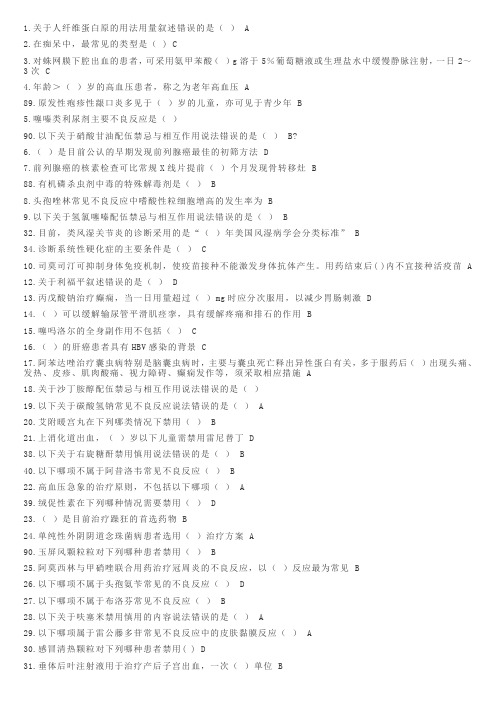
1.关于人纤维蛋白原的用法用量叙述错误的是() A2.在痴呆中,最常见的类型是( ) C3.对蛛网膜下腔出血的患者,可采用氨甲苯酸()g溶于5%葡萄糖液或生理盐水中缓慢静脉注射,一日2~3次 C4.年龄>()岁的高血压患者,称之为老年高血压 A89.原发性疱疹性龈口炎多见于()岁的儿童,亦可见于青少年 B5.噻嗪类利尿剂主要不良反应是()90.以下关于硝酸甘油配伍禁忌与相互作用说法错误的是() B?6.()是目前公认的早期发现前列腺癌最佳的初筛方法 D7.前列腺癌的核素检查可比常规X线片提前()个月发现骨转移灶 B88.有机磷杀虫剂中毒的特殊解毒剂是() B8.头孢唑林常见不良反应中嗜酸性粒细胞增高的发生率为 B9.以下关于氢氯噻嗪配伍禁忌与相互作用说法错误的是() B32.目前,类风湿关节炎的诊断采用的是“()年美国风湿病学会分类标准” B34.诊断系统性硬化症的主要条件是() C10.司莫司汀可抑制身体免疫机制,使疫苗接种不能激发身体抗体产生。
用药结束后( )内不宜接种活疫苗 A12.关于利福平叙述错误的是() D13.丙戊酸钠治疗癫痫,当一日用量超过()mg时应分次服用,以减少胃肠刺激 D14.()可以缓解输尿管平滑肌痉挛,具有缓解疼痛和排石的作用 B15.噻吗洛尔的全身副作用不包括() C16.()的肝癌患者具有HBV感染的背景 C17.阿苯达唑治疗囊虫病特别是脑囊虫病时,主要与囊虫死亡释出异性蛋白有关,多于服药后()出现头痛、发热、皮疹、肌肉酸痛、视力障碍、癫痫发作等,须采取相应措施 A18.关于沙丁胺醇配伍禁忌与相互作用说法错误的是()19.以下关于碳酸氢钠常见不良反应说法错误的是() A20.艾附暖宫丸在下列哪类情况下禁用() B21.上消化道出血,()岁以下儿童需禁用雷尼替丁 D38.以下关于右旋糖酐禁用慎用说法错误的是() B40.以下哪项不属于阿昔洛韦常见不良反应() B22.高血压急象的治疗原则,不包括以下哪项() A39.绒促性素在下列哪种情况需要禁用() D23.()是目前治疗躁狂的首选药物 B24.单纯性外阴阴道念珠菌病患者选用()治疗方案 A90.玉屏风颗粒粒对下列哪种患者禁用() B25.阿莫西林与甲硝唑联合用药治疗冠周炎的不良反应,以()反应最为常见 B26.以下哪项不属于头孢氨苄常见的不良反应() D27.以下哪项不属于布洛芬常见不良反应() B28.以下关于呋塞米禁用慎用的内容说法错误的是() A29.以下哪项属于雷公藤多苷常见不良反应中的皮肤黏膜反应() A30.感冒清热颗粒对下列哪种患者禁用( ) D31.垂体后叶注射液用于治疗产后子宫出血,一次()单位 B32.以下对于硝普钠使用注意事项的认识,错误的是() B33.碳酸锂的有效剂量范围为()mg/d,偶尔可达2000mg/d34.接受血管内注射碘化造影剂检查前后()小时应暂停用二甲双胍 B35.系统性红斑狼疮目前普遍采用美国风湿病学会()年推荐的SLE分类标准诊断,符合该分类标准的11项中4项或4项以上者,在除外感染、肿瘤和其他结缔组织病后,可诊断SLE B36.维生素()一日剂量超过500mg可致感觉神经障碍 B37.头孢唑林不良反应中药疹发生率为() A38.以下关于凝血酶的禁用慎用说法错误的是() D39.维A酸在妊娠起初()内妇女禁用 A40.柴胡注射液忌与()配伍 A41.关于琥珀酸亚铁的叙述错误的是() C42.关于精蛋白重组人胰岛素混合注射液叙述错误的是() C43.苯海拉明禁忌证包括() C41.下列属于黄体酮禁忌证的是() A44.氨茶碱治疗慢性阻塞性肺病,静脉给药极量为() C40.下列关于维生素C配伍禁忌与相互作用说法错误的是() C35.依托泊苷联合顺铂(EP)方案自()年首次被证实是治疗小细胞肺癌有效的方案44.精神分裂症的维持期治疗时间为() D45.在治疗亚硝酸盐中毒时,应严格控制亚甲蓝剂量,大剂量(10mg/kg)作用相反,可导致() D46.巴氏腺脓肿患者首选治疗药物是()160万单位,肌内注射,一日2次 C47.喉炎的主要症状是() D48.腮腺炎的首发体征是() D51.右旋糖酐铁的适应证包括a()52.羟乙基淀粉成人一日最大剂量为()ml/kg D?53.卡马西平对治疗急性躁狂和预防躁狂发作均有效,应从小剂量开始,逐渐增加至()mg/d,分2~3次口服 B54.非ST段抬高心肌梗死,心绞痛发作时可出现2个或更多的相邻导联ST段下移≥()mV B55.下列关于痤疮的诊断要点说法错误的是() B56.非透析的终末期肾脏病患者要严格控制饮食中蛋白质,一般为每天每千克体重() C57.急性前列腺炎患者在未明确致病菌前,应首先静脉使用(a )抗菌药物58.用于治疗绝经过渡期功血时,炔诺酮每日5~10mg,顿服,2~3日血止后可每隔3日递减()量,至维持量一日5mg,持续用至血止后21日停药 D59.非小细胞肺癌患者中体力状态评分为()分者和年老者可选择单药化疗 B60.伤科接骨片对孕妇和()以下小儿禁用 A61.下列哪种抗生素18岁以下患者不宜使用() C7.下列关于急性化脓性腮腺炎的诊断要点说法错误的是() A34.食管癌化疗无论腺、鳞癌,()和顺铂都是基础的治疗药物 C62.()除用于治疗钩虫、蛔虫、鞭虫、蛲虫、旋毛虫等线虫病外,还可用于治疗囊虫和包虫病 D35.如果氯霉素与青霉素联用宜先用青霉素()小时后再用氯霉素 B63.卡马西平的适应证不包括() D64.美西律的适应证是(a )65.硫唑嘌呤用于器官移植时,口服成人每日()mg/kg B66.支气管扩张症胸部X线检查的表现,错误的是() C47.约()系统性硬化症的患者有不同程度的心脏受累 B67.再出血是蛛网膜下腔出血致命性的并发症,在()内的危险性最大 C68.以下哪种疾病行走时呈“慌张步态”() D69.抗癫痫药的治疗原则,认识错误的是() D47.()患者禁用碳酸锂 B46.水痘的典型临床表现,错误的是() C70.以下哪项属于溴己新严重的不良反应() D71.()用于手术结束时拮抗非去极化肌肉松弛药的残留肌松作用,用于重症肌无力,手术后功能性肠胀气及尿潴留等 A72.()可通过胎盘屏障,故妊娠后期母体用量可能增加,分娩后6周须减量 C73.丙酸睾酮用于男性性腺功能减退症的激素替代治疗:一次()mg,一周()次 B74.环磷酰胺片剂:成人,口服每日2~4mg/kg,连用10~14日,停药(a )周后重复使用60.黄连上清丸对下列哪种患者禁用() C75.维生素B2大量服用后尿呈(a)76.抗狂犬病血清过敏试验:用氯化钠注射液将抗血清稀释()倍,在前臂掌侧皮内注射0.05ml,观察30分钟 B77.以下对慢性粒细胞白血病慢性期的认识,错误的是() D78.()是确诊胃癌的金标准 D54.关于阿糖胞苷叙述错误的是() C55.关于咪康唑叙述错误的是() B79.为防止急性风湿热的发生,用克林霉素治疗溶血性链球菌感染时的疗程至少为() D80.卡托普利常见不良反应中,味觉丧失:发生率为(),表现为味觉扰乱或丧失,有些可自行恢复 B81.()宜在饭前1小时或饭后2小时口服 B82.关于双嘧达莫叙述错误的是() C83.低精蛋白锌胰岛素注射液皮下注射后吸收缓慢而均匀,()小时血药浓度达峰值 B63.无起搏器保护的窦房结功能障碍、严重的房室传导阻滞、双束支传导阻滞者、严重充血性心力衰竭、心源性休克、严重低血压者禁用() B61.双氯芬酸钠的适应证不包括下列哪项() B84.螺内酯适用于中重度心衰、NYHAⅢ、Ⅳ级患者,或心肌梗死后心衰、LVEF<()的患者 C59.右旋糖酐一日用量宜≤(),过量易引起出血倾向和低蛋白血症 A85.过敏性紫癜单纯皮肤或关节病变者,急性期必要时可给予糖皮质激素以缓解症状,减轻炎症渗出,但糖皮质激素疗程一般不超过()天 B?86.强直性脊柱炎最常见的特征性症状为() A87.()是治疗宫颈癌的主要方法,适用于Ⅰb期及其以后各期患者,即使对Ⅳ期也能起到姑息作用 B88.首次输用右旋糖酐,开始几毫升应缓慢静脉滴注,并在注射开始后严密观察()分钟,出现不正常征象(寒战、皮疹等)时应马上停药 C89.以下哪种情况下维生素B2需要禁用() B90.正柴胡饮颗粒对下列哪种患者禁用( ) C91.劳拉西泮用于治疗焦虑症,口服每次(),一日2~3次 B92.猝死的临床判断可根据以下三点,其中不包括() D93.使用以下哪种时容易出现硫氰酸盐中毒() A94.卡马西平治疗癫痫,一般每日最高剂量不超过()mg D95.钙离子拮抗剂治疗高血压,主要不良反应是() B97.短暂性脑缺血发作患者使用钙通道阻滞药:可扩张脑血管,防止脑动脉痉挛。
美国NCCN 神经系统肿瘤治疗指南

美国NCCN 神经系统肿瘤治疗指南(2008)的介绍及解读发表时间:2009-08-02发表者:马文斌 (访问人次:650)美国NCCN神经系统肿瘤治疗指南(2008)的介绍及解读作者:北京协和医院神经外科马文斌,郭旭, 王任直美国国家综合肿瘤网(National Comprehensive Cancer Network,NCCN)公布的肿瘤治疗指南,系由美国著名的肿瘤学家依照临床循证医学的资料制定;指南对常见的肿瘤治疗方案每年均进行更新,是国际上最权威的指南之一,且已被全球的肿瘤工作者广泛采用并作为恶性肿瘤治疗的重要参考依据。
结合我国目前神经系统恶性肿瘤治疗的实际认真解读NCCN指南,将会推动我国神经系统恶性肿瘤规范化及个体化综合治疗的开展。
1.指南所涉及的神经系统肿瘤及其概述2008版指南所涉及主要是CNS恶性肿瘤,包括低级别浸润性星形细胞瘤、少突胶质细胞瘤、室管膜瘤;高级别星形细胞瘤包括胶质母细胞瘤;颅内转移瘤、癌性/淋巴瘤性脑膜炎;原发性中枢神经系统淋巴瘤以及椎管内转移瘤。
1.1虽经过神经肿瘤学工作者30多年不懈的努力,但恶性胶质瘤病人的预后仍不满意。
197 8年Walker MD报道,仅进行支持治疗,多形性胶母细胞瘤(GBM)平均生存不足3个月,9 7%在1年内死亡;经历30年后,美国2002年脑肿瘤登记调查结果表明诊断GBM后,患者平均生存期仍少于1年,5年生存率低于3%。
因此恶性胶质瘤仍是神经外科目前治疗难点之一。
1.2 中枢神经淋巴瘤(PCNSL)发病率和患病率在过去的40年呈增长趋势,由原来占CNS 肿瘤的1%~2% 上升到5%~7%,且由于AIDS 的流行和心肺肾等器官移植后免疫抑制剂使用的增加,本病还有上升的趋势;另外随着以CD20为靶标的嵌合型抗体药物美罗华的问世,中枢神经系统淋巴瘤的治疗策略有了很大改变,以化疗为主的治疗效果有了很大提高。
1.3 随着新的细胞毒药物和分子靶向药物的应用,很多原发肿瘤患者的生存期有了很大提高;但由于血脑屏障这一主要原因,加之影像学进步和老龄化到来,脑转移瘤的发病率亦有升高。
美国感染病学会颅内感染性脑室炎和脑膜炎治疗指南中文版
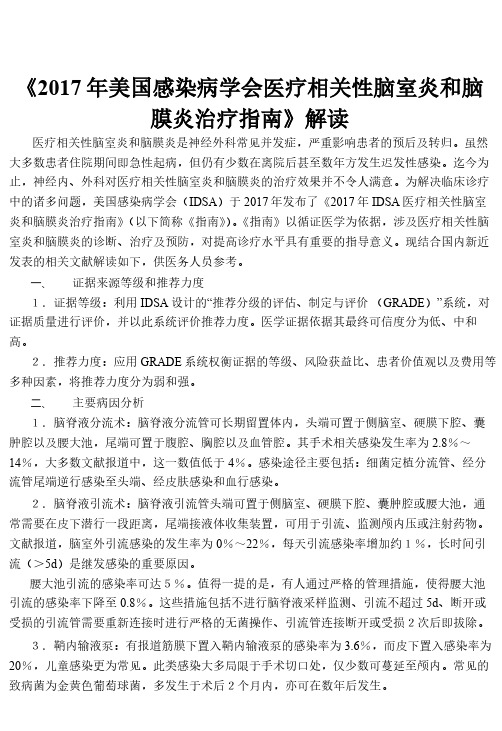
《2017年美国感染病学会医疗相关性脑室炎和脑膜炎治疗指南》解读医疗相关性脑室炎和脑膜炎是神经外科常见并发症,严重影响患者的预后及转归。
虽然大多数患者住院期间即急性起病,但仍有少数在离院后甚至数年方发生迟发性感染。
迄今为止,神经内、外科对医疗相关性脑室炎和脑膜炎的治疗效果并不令人满意。
为解决临床诊疗中的诸多问题,美国感染病学会(IDSA)于2017年发布了《2017年IDSA医疗相关性脑室炎和脑膜炎治疗指南》(以下简称《指南》)。
《指南》以循证医学为依据,涉及医疗相关性脑室炎和脑膜炎的诊断、治疗及预防,对提高诊疗水平具有重要的指导意义。
现结合国内新近发表的相关文献解读如下,供医务人员参考。
一、证据来源等级和推荐力度1.证据等级:利用IDSA设计的“推荐分级的评估、制定与评价(GRADE)”系统,对证据质量进行评价,并以此系统评价推荐力度。
医学证据依据其最终可信度分为低、中和高。
2.推荐力度:应用GRADE系统权衡证据的等级、风险获益比、患者价值观以及费用等多种因素,将推荐力度分为弱和强。
二、主要病因分析1.脑脊液分流术:脑脊液分流管可长期留置体内,头端可置于侧脑室、硬膜下腔、囊肿腔以及腰大池,尾端可置于腹腔、胸腔以及血管腔。
其手术相关感染发生率为2.8%~14%,大多数文献报道中,这一数值低于4%。
感染途径主要包括:细菌定植分流管、经分流管尾端逆行感染至头端、经皮肤感染和血行感染。
2.脑脊液引流术:脑脊液引流管头端可置于侧脑室、硬膜下腔、囊肿腔或腰大池,通常需要在皮下潜行一段距离,尾端接液体收集装置,可用于引流、监测颅内压或注射药物。
文献报道,脑室外引流感染的发生率为0%~22%,每天引流感染率增加约1%,长时间引流(>5d)是继发感染的重要原因。
腰大池引流的感染率可达5%。
值得一提的是,有人通过严格的管理措施,使得腰大池引流的感染率下降至0.8%。
这些措施包括不进行脑脊液采样监测、引流不超过5d、断开或受损的引流管需要重新连接时进行严格的无菌操作、引流管连接断开或受损2次后即拔除。
美国感染病学会颅内感染性脑室炎和脑膜炎治疗指南中文版

《2017年美国感染病学会医疗相关性脑室炎和脑膜炎治疗指南》解读医疗相关性脑室炎和脑膜炎是神经外科常见并发症,严重影响患者的预后及转归。
虽然大多数患者住院期间即急性起病,但仍有少数在离院后甚至数年方发生迟发性感染。
迄今为止,神经内、外科对医疗相关性脑室炎和脑膜炎的治疗效果并不令人满意。
为解决临床诊疗中的诸多问题,美国感染病学会(IDSA)于2017年发布了《2017年IDSA医疗相关性脑室炎和脑膜炎治疗指南》(以下简称《指南》)。
《指南》以循证医学为依据,涉及医疗相关性脑室炎和脑膜炎的诊断、治疗及预防,对提高诊疗水平具有重要的指导意义。
现结合国内新近发表的相关文献解读如下,供医务人员参考。
一、证据来源等级和推荐力度1.证据等级:利用IDSA设计的“推荐分级的评估、制定与评价(GRADE)”系统,对证据质量进行评价,并以此系统评价推荐力度。
医学证据依据其最终可信度分为低、中和高。
2.推荐力度:应用GRADE系统权衡证据的等级、风险获益比、患者价值观以及费用等多种因素,将推荐力度分为弱和强。
二、主要病因分析1.脑脊液分流术:脑脊液分流管可长期留置体内,头端可置于侧脑室、硬膜下腔、囊肿腔以及腰大池,尾端可置于腹腔、胸腔以及血管腔。
其手术相关感染发生率为2.8%~14%,大多数文献报道中,这一数值低于4%。
感染途径主要包括:细菌定植分流管、经分流管尾端逆行感染至头端、经皮肤感染和血行感染。
2.脑脊液引流术:脑脊液引流管头端可置于侧脑室、硬膜下腔、囊肿腔或腰大池,通常需要在皮下潜行一段距离,尾端接液体收集装置,可用于引流、监测颅内压或注射药物。
文献报道,脑室外引流感染的发生率为0%~22%,每天引流感染率增加约1%,长时间引流(>5d)是继发感染的重要原因。
腰大池引流的感染率可达5%。
值得一提的是,有人通过严格的管理措施,使得腰大池引流的感染率下降至0.8%。
这些措施包括不进行脑脊液采样监测、引流不超过5d、断开或受损的引流管需要重新连接时进行严格的无菌操作、引流管连接断开或受损2次后即拔除。
美国重型颅脑损伤诊治指南解读
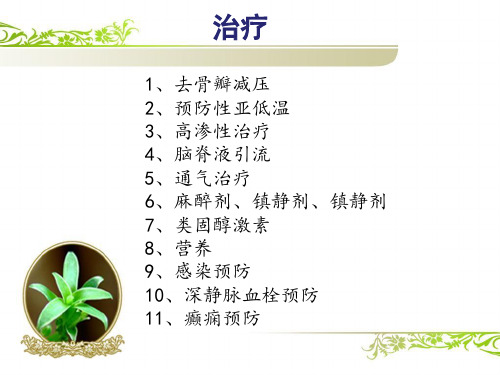
之小额颞顶减压,推荐使用大额颞顶减压(不小于 12×15cm或直径15cm)
2、预防性亚低温
• 目前认为亚低温能够在代谢紊乱时保护细胞和组织 • 亚低温治疗的作用主要是保护神经元以及降低颅内压 • “预防性亚低温”在损伤的早期和颅内压升高之前使用 • “治疗性亚低温”作为顽固性颅内压升高的治疗手段
• 总体获益大于该操作并发症时,推荐早期气管切开可减 少机械通气天数。
• 不推荐使用碘伏口腔护理以减少呼吸机相关肺炎,并且 它可增加ARDS的发生。
• 放置脑室外引流管时抗菌浸渍的导管被认为可预防导管 相关感染。
10、深静脉血栓预防
因存在原发颅脑损伤所致高凝状态、长时间卧床和局灶性运动功能障碍, 重型TBI患者有发生VTE的高风险。
此版指南并没有相关推荐。。。
• 推荐至少在伤后5天-7天内对于不能主动进食患者给予基础热量补偿。 • 推荐经胃-空肠营养以降低呼吸机相关肺炎发病率。
与之前版本指南的差别: 更加强调早期给予营养及给予途径,其余无变化。
9、感染预防
重型颅脑损伤因必要的机械通气预防气道梗阻、误吸和相对缺氧,以及 有创监测,会增加患者的感染易感性
• 不推荐在早期(2.5小时内)及短期(伤后48小时)预 防性低温治疗来改善创伤患者的预后。
3、高渗性治疗
• 过去认为甘露醇通过单纯脱水以达到降颅内压的目的 • 其实,甘露醇以及高渗盐水,至少部分通过降低血粘度,改善微循环的
血流从而收缩软脑膜微小动脉,导致脑血流容积降低来降低颅内压力。
• 剂量为0.25-1g/kg 的甘露醇能有效控制升高的ICP。应避 免动脉压过低(收缩压<90mmHg)。
Medscape:2013神经病学重大研究进展(一)
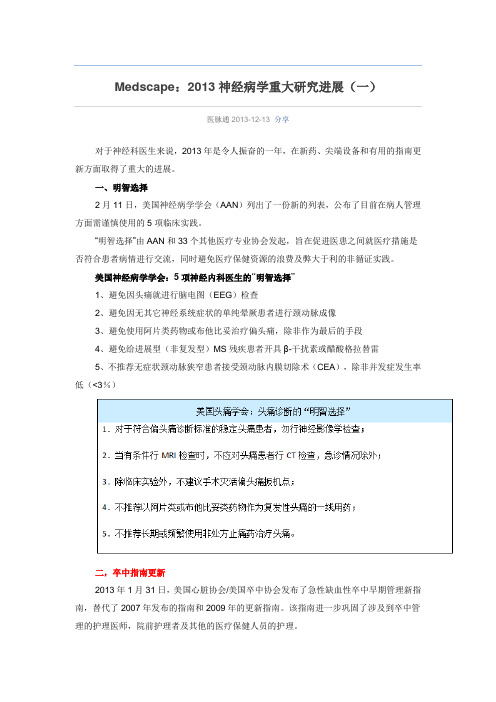
Medscape:2013神经病学重大研究进展(一)医脉通2013-12-13分享对于神经科医生来说,2013年是令人振奋的一年,在新药、尖端设备和有用的指南更新方面取得了重大的进展。
一、明智选择2月11日,美国神经病学学会(AAN)列出了一份新的列表,公布了目前在病人管理方面需谨慎使用的5项临床实践。
“明智选择”由AAN和33个其他医疗专业协会发起,旨在促进医患之间就医疗措施是否符合患者病情进行交流,同时避免医疗保健资源的浪费及弊大于利的非循证实践。
美国神经病学学会:5项神经内科医生的“明智选择”1、避免因头痛就进行脑电图(EEG)检查2、避免因无其它神经系统症状的单纯晕厥患者进行颈动脉成像3、避免使用阿片类药物或布他比妥治疗偏头痛,除非作为最后的手段4、避免给进展型(非复发型)MS残疾患者开具β-干扰素或醋酸格拉替雷5、不推荐无症状颈动脉狭窄患者接受颈动脉内膜切除术(CEA),除非并发症发生率低(<3%)二,卒中指南更新2013年1月31日,美国心脏协会/美国卒中协会发布了急性缺血性卒中早期管理新指南,替代了2007年发布的指南和2009年的更新指南。
该指南进一步巩固了涉及到卒中管理的护理医师,院前护理者及其他的医疗保健人员的护理。
指南的目的是降低卒中发病率和卒中相关死亡率。
本指南讨论了卒中的早期评估和一般性治疗,以及缺血性卒中特殊的干预措施,如再灌注策略以及脑复苏的最优化措施。
该指南与之前2007年发布的指南相比,并没有革命性的变化,但却是有渐进性的改进,指南巩固了我们对一些因素的理解。
本指南是一个解决卒中管理的全面性的文件,从属于卒中并发症的院前评估,那些涉及到卒中护理的人们值得一读。
详情阅读》》》AHA/ASA指南更新:急性缺血性卒中早期管理三,卒中与TIA:CHANCE研究6月26日发表在《新英格兰医学杂志》上的CHANCE(氯吡格雷用于急性非致残性脑血管事件高危人群的疗效)研究结果,表明阿司匹林与氯吡格雷联合用药比阿司匹林单一用药更有助于防止卒中复发。
第四版美国重型颅脑损伤诊疗指引
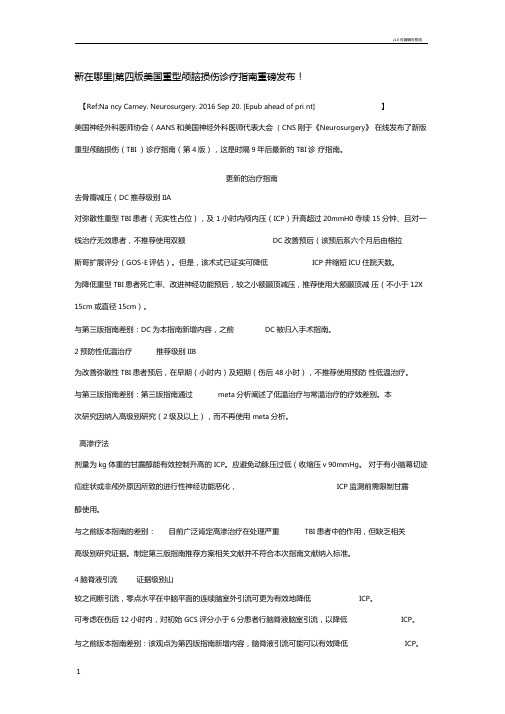
新在哪里|第四版美国重型颅脑损伤诊疗指南重磅发布!【Ref:Na ncy Carney. Neurosurgery. 2016 Sep 20. [Epub ahead of pri nt] 】美国神经外科医师协会(AANS和美国神经外科医师代表大会(CNS刚于《Neurosurgery》在线发布了新版重型颅脑损伤(TBI )诊疗指南(第4版),这是时隔9年后最新的TBI诊疗指南。
更新的治疗指南去骨瓣减压(DC 推荐级别IIA对弥散性重型TBI患者(无实性占位),及1小时内颅内压(ICP)升高超过20mmH0寺续15分钟、且对一线治疗无效患者,不推荐使用双额DC改善预后(该预后系六个月后由格拉斯哥扩展评分(GOS-E评估)。
但是,该术式已证实可降低ICP并缩短ICU住院天数。
为降低重型TBI患者死亡率、改进神经功能预后,较之小额颞顶减压,推荐使用大额颞顶减压(不小于12X 15cm或直径15cm)。
与第三版指南差别:DC为本指南新增内容,之前DC被归入手术指南。
2预防性低温治疗推荐级别IIB为改善弥散性TBI患者预后,在早期(小时内)及短期(伤后48小时),不推荐使用预防性低温治疗。
与第三版指南差别:第三版指南通过meta分析阐述了低温治疗与常温治疗的疗效差别。
本次研究因纳入高级别研究(2级及以上),而不再使用meta分析。
高渗疗法剂量为kg体重的甘露醇能有效控制升高的ICP。
应避免动脉压过低(收缩压v 90mmHg。
对于有小脑幕切迹疝症状或非颅外原因所致的进行性神经功能恶化,ICP监测前需限制甘露醇使用。
与之前版本指南的差别:目前广泛肯定高渗治疗在处理严重TBI患者中的作用,但缺乏相关高级别研究证据。
制定第三版指南推荐方案相关文献并不符合本次指南文献纳入标准。
4脑脊液引流证据级别山较之间断引流,零点水平在中脑平面的连续脑室外引流可更为有效地降低ICP。
可考虑在伤后12小时内,对初始GCS评分小于6分患者行脑脊液脑室引流,以降低ICP。
脑囊虫病的诊断与治疗
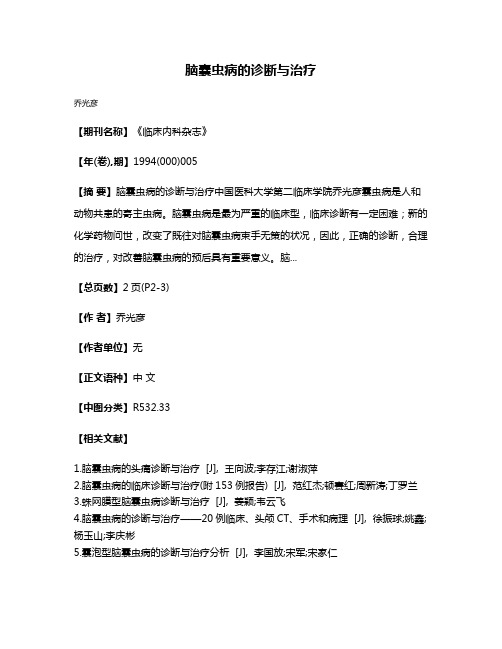
脑囊虫病的诊断与治疗
乔光彦
【期刊名称】《临床内科杂志》
【年(卷),期】1994(000)005
【摘要】脑囊虫病的诊断与治疗中国医科大学第二临床学院乔光彦囊虫病是人和动物共患的寄主虫病。
脑囊虫病是最为严重的临床型,临床诊断有一定困难;新的化学药物问世,改变了既往对脑囊虫病束手无策的状况,因此,正确的诊断,合理的治疗,对改善脑囊虫病的预后具有重要意义。
脑...
【总页数】2页(P2-3)
【作者】乔光彦
【作者单位】无
【正文语种】中文
【中图分类】R532.33
【相关文献】
1.脑囊虫病的头痛诊断与治疗 [J], 王向波;李存江;谢淑萍
2.脑囊虫病的临床诊断与治疗(附153例报告) [J], 范红杰;顿赛红;周新涛;丁罗兰
3.蛛网膜型脑囊虫病诊断与治疗 [J], 姜颖;韦云飞
4.脑囊虫病的诊断与治疗——20例临床、头颅CT、手术和病理 [J], 徐振球;姚鑫;杨玉山;李庆彬
5.囊泡型脑囊虫病的诊断与治疗分析 [J], 李国放;宋军;宋家仁
因版权原因,仅展示原文概要,查看原文内容请购买。
[指南]中枢神经系统感染
![[指南]中枢神经系统感染](https://img.taocdn.com/s3/m/9850499e85868762caaedd3383c4bb4cf7ecb711.png)
中枢神经系统感染中枢神经系统感染包括脑膜炎(脑膜或脊膜的炎症),大脑炎(中枢神经系统受到细菌侵犯出现的脑部临床表现),脑炎(中枢神经系统病毒感染引起的脑部临床表现),脓肿以及蠕虫感染。
中枢神经系统对各种病原体的侵犯有较强的抵抗力,但是脑和脊髓一旦受到感染则后果非常严重。
简介中枢神经系统的感染性疾病,按病因分有病毒、细菌、立克次体、螺旋体、真菌、寄生虫等引起的疾病。
中枢神经系统对各种病原体的侵犯有较强的抵抗力,但是脑和脊髓一旦受到感染则后果非常严重。
如脑(脊)膜炎,通常由细菌或病毒感染引起。
无菌性脑膜炎有时用来指病毒引起的脑膜炎症,但也可由自身免疫反应(如发生多发性硬化)、药物副作用(如布洛芬)或骨髓腔注入化学物质引起。
脑炎是脑组织的炎症,常由病毒感染引起,也可以由自身免疫反应引起。
脓肿是局限的感染,可在身体各部位形成,包括脑。
细菌和其他感染源可通过多种途径感染中枢神经系统。
可由血行感染或直接感染通过穿通性外伤、手术或邻近组织感染蔓延入颅。
病理由于个体免疫反应的差异,同一病原体可以引起轻的、反复的甚至致死的疾病,也可以不引起疾病。
血液中的蛋白不能轻易地弥散进入CNS,因此不利于抗体的产生。
脑脊液(CSF)正常时可见到IgG及IgA但无IgM,因为IgM分子量要大些。
体液免疫反应,往往形成抗原抗体复合体。
这种反应常在血管内进行,导致神经组织内或邻近组织的严重的血管炎性反应。
炎性反应CNS感染引起的炎性反应:由于病原体的毒力及机体的反应可表现(1)化脓性炎性反应,常由于化脓性细菌引起;(2)非化脓性炎性反应,如由于斑疹伤寒;(3)出血性反应,见于炭疽及某些病毒感染时;(4)组织细胞及肉芽肿性反应,见于慢性炎症过程。
髓鞘破坏CNS感染时常有髓鞘的破坏:髓鞘的破坏可继发于神经元的受损,即神经元溶解性脱髓鞘(neuronolyticdemyelination),另外一种称为轴周脱髓鞘(periaxialdemylination)。
阿苯达唑的临床应用

阿苯达唑的临床应用摘要】阿苯达唑系一种广谱、高效、低毒的驱虫新药。
本文着重探讨阿苯达唑的药理、毒理,在临床的应用范围、治疗效果。
本药的毒副反应与剂量及所治病种有一定关系。
【关键词】阿苯达唑药理毒理临床应用毒副反应【中图分类号】R969 【文献标识码】A 【文章编号】1672-5085(2013)38-0153-02阿苯达唑(albendazole)又名丙硫咪唑,系一种广谱、高效、低廉的驱虫新药。
1 药理和毒理本药在体内迅速代谢为亚砜或砜,抑制寄生虫对葡萄糖的吸收,导致虫体糖原耗竭和抑制延胡索酸还原酶系统,阻碍三磷酸腺苷的生产,致使虫体无法发育与生存。
本药还有杀死钩虫卵与鞭虫卵的效果,对蛔虫卵亦有一定作用。
在体内分布依次为肝、肾、肌肉,可透过血脑屏障,血液中半衰期为3.5-10.5 小时,代谢产物在24 小时内60% 从尿中排出,20% 从粪便排出,在体内无蓄积作用[1]。
本品小老鼠口服L D 为5120 毫克/ 公斤,对鼠的体重、血象、肝肾功能等均未见影响,但有致畸作用[1]。
2临床应用2.1 线虫病2.1.1 蛔虫蔡士椿等用400 毫克顿服或连服2-3 天,虫卵阴转率为86.4%-100%[3-6]。
表明400毫克顿服已收到较好效果。
但Rossignol报道,成人及重度感染的疗效稍差[6],因此,治疗蛔虫病可采用400 毫克顿服,重度感染者宜连服2 天。
2.1.2 钩虫吴中兴,张孝蓉等用400 毫克顿服,连服2-5 天,虫卵阴转率为86.8%—98.6% [4-5]。
400 毫克顿服,连服3-5 天,对控制钩虫感染率回升较有意义[5]。
2.1.3 蛲虫本药驱蛲虫效果较佳,儿童顿服200 毫克,虫卵阴转率达99% 以上[7]。
但是,蛲虫易自身重复感染,所以多主张连服2-3 次,每次间隔2-3 周,本疗法虫卵阴转率可达100%[7]。
2.1.4 鞭虫本药驱鞭虫效果不理想,尤其是重度感染者[6]。
400 毫克顿服或连服2 天,虫卵转阴率仅达36.0%-52.7%[3-4]。
- 1、下载文档前请自行甄别文档内容的完整性,平台不提供额外的编辑、内容补充、找答案等附加服务。
- 2、"仅部分预览"的文档,不可在线预览部分如存在完整性等问题,可反馈申请退款(可完整预览的文档不适用该条件!)。
- 3、如文档侵犯您的权益,请联系客服反馈,我们会尽快为您处理(人工客服工作时间:9:00-18:30)。
Ruth Ann Baird,MD Sam Wiebe,MD Joseph R.Zunt,MD, MPHJohn J.Halperin,MD, FAANGary Gronseth,MD, FAANKaren L.Roos,MD, FAAN Correspondence toAmerican Academy of Neurology: guidelines@ Supplemental data at ABSTRACTObjective:To review the evidence base for different treatment strategies in intraparenchymal neurocysticercosis in adults and children.Method:A literature search of Medline,EMBASE,LILACS,and the Cochrane Database from1980 to2008,updated in2012,resulted in the identification of10Class I or Class II trials of cysticidal drugs administered with or without corticosteroids in the treatment of neurocysticercosis. Results:The available data demonstrate that albendazole therapy,administered with or without corticosteroids,is probably effective in decreasing both long-term seizure frequency and the number of cysts demonstrable radiologically in adults and children with neurocysticercosis,and is well-tolerated.There is insufficient information to assess the efficacy of praziquantel. Recommendations:Albendazole plus either dexamethasone or prednisolone should be considered for adults and children with neurocysticercosis,both to decrease the number of active lesions on brain imaging studies(Level B)and to reduce long-term seizure frequency(Level B).The evidence is insufficient to support or refute the use of steroid treatment alone in patients with intraparen-chymal neurocysticercosis(Level U).Neurologyâ2013;80:1424–1429GLOSSARYAED5antiepileptic drug;CI5confidence interval;RCT5randomized controlled trial.Cysticercosis,infection with the larval form of Taeniasolium,is widely prevalent in developing countries ofAfrica,Asia,and Latin America.It is considered by theWHO to be the most common preventable cause ofepilepsy in the developing world,with an estimated2million people having epilepsy caused by T soliuminfection.1Humans can acquire2different forms ofinfection—by eating raw or undercooked pork contain-ing T solium cysts or by eating food contaminated withT solium eggs.Cysts consumed in undercooked meatmature into adult parasites in the human intestine,atwhich time they release eggs and gravid proglottids inthe stool.This form of intestinal infection is called tae-niasis.When T solium eggs are consumed,throughfecal–oral transmission from another human with tae-niasis or through autoinfection,they release onco-spheres into the host’s digestive tract and can thenmigrate throughout the host’s body,becoming encystedin end organs.This systemic infection is called cysticer-cosis.Seeding of larvae in the CNS results in neuro-cysticercosis.Neurocysticercosis,in turn,may affect theCNS parenchyma or the CSF space.In this guideline,we focus solely on parenchymal infections.Cysticercal cysts evolve through4stages,with differ-ent appearances on neuroimaging—the vesicular stage,where the cyst contains a living larva;a colloidal stage asthe larva degenerates;a“granulo-nodular”stage as themembrane of the cyst thickens;and the final stage ofcalcification.Only cysts in the vesicular and colloidalstages contain live larvae2and are amenable to anticy-sticercal treatment.Encysted larvae can remain asymp-tomatic for years.When the larvae do elicit a hostimmune response,patients can develop brain edemaand,more often,seizures.Optimal treatment of thisFrom the Departments of Clinical Neurology(R.A.B.)and Neurology and Neurological Surgery(K.L.R.),Indiana University School of Medicine, Indianapolis;Division of Neurology(S.W.),University of Calgary,Calgary,Canada;Department of Neurology(J.R.Z.),University of Washington, Seattle;Department of Neurosciences(J.J.H.),Overlook Medical Center,Summit,NJ;Department of Neurology and Medicine(J.J.H.),Mount Sinai School of Medicine,New York,NY;and Department of Neurology(G.G.),University of Kansas,Kansas City,KS.Appendices e-1through e-8and the e-tables are available as data supplements on the Neurology®website at .Accepted for publication by the Guideline Development Subcommittee on July14,2012;by the Practice Committee on July24,2012;and by the AAN Board of Directors on December26,2012.Go to for full disclosures.Funding information and disclosures deemed relevant by the authors,if any,are provided at the end of the article.1424©2013American Academy of Neurologyinfection has been the subject of considerable debate, with controversy regarding the appropriate role of both corticosteroids and cysticidal drugs such as praziquantel or albendazole for active infections.To address this controversy,we performed a sys-tematic review of the literature regarding the follow-ing specific clinical questions:1.In patients with symptomatic intraparenchymalneurocysticercosis,is cysticidal therapy more effec-tive than no therapy,and does it affect long-term seizure outcome?2.In patients with symptomatic intraparenchymal neu-rocysticercosis,is treatment with corticosteroids more effective than no treatment?3.When during the course of antiparasitic treatment should steroids be started?4.What is the efficacy of antiepileptic drugs(AEDs)in treating or decreasing occurrence of subsequent seiz-ures secondary to intraparenchymal neurocysticerco-sis,and what is the optimal time course of AED treatment for seizures secondary to intraparenchymal neurocysticercosis?DESCRIPTION OF THE ANALYTIC PROCESS Because cysticercosis is quite prevalent in Latin America,a number of relevant studies have been published in the Spanish-language literature.Therefore,a com-prehensive search was performed of both English-and Spanish-language articles(with the latter reviewed by2 panel members,J.R.Z.and S.W.,who are fluent in Span-ish)in Medline,EMBASE,LILACS,and Cochrane Database of Systematic Reviews from1980to2008, using the search terms“neurocysticercosis,”“cerebral cys-ticercosis,”“brain cysticercosis,”“antiparasitic agents,”“antihelmintics,”“cysticidal,”“clinical trials,”“research design,”“antiseizure,”“anticonvulsant,”“antiepileptic,”“albendazole,”“praziquantel,”“steroid,”“corticosteroid,”“anti-inflammatory agents,”“hydrocortisone,”“predni-sone,”“prednisolone,”“dexamethasone,”and“neurosur-gery”(see appendix e-1on the Neurology®Web site at for complete search strategy).The search identified590citations.An updated search of Medline and the Cochrane Database of Systematic Re-views was performed in January2012and identified an additional20citations.Each abstract was reviewed by at least2reviewers.Review articles without primary data, case reports,and small case series were discarded.The remaining pertinent123articles were reviewed in detail, and data regarding cohort size,patient characteristics, inclusion and exclusion criteria,completion rate, treatment and dosage,study design,study length, primary and secondary outcomes,efficacy,and effect size were extracted from each article and tabulated using a data extraction form.Each article was classified according to the American Academy of Neurology therapeutic clas-sification of evidence scheme(see appendix e-4).Risk differences with95%confidence intervals(CIs) were used as the preferred measure of effect and statisti-cal precision.When necessary to increase statistical pre-cision,studies with the lowest risk of bias were pooled in a fixed-effects meta-analysis.Class II studies were included in the meta-analysis only when precision was insufficient after Class I studies were pooled. ANALYSIS OF EVIDENCE In patients with symptomatic intraparenchymal neurocysticercosis,is cysticidal therapy more effective than no therapy,and does it affect long-term seizure outcome?Treatment efficacy can be judged by a radiologic surrogate marker—the numbers of remain-ing active and inactive cysts—and clinically by the num-ber of patients experiencing seizures after treatment.Of note in these studies,patients received anticonvulsants initially,most often phenytoin,but this was not explicitly controlled as part of the treatment protocols.Also of note,although some of the cited studies were limited to patients with active cysts,some included individuals with transitional cysts,in which the parasite is already dead or dying.Because cysticidal therapy would not be expected to affect the disease course if the organism were already dead,this may actually have led to an underesti-mation of treatment efficacy.Three Class I325(1Class I for imaging only5and Class IV for clinical measures,including seizure fre-quency)and6Class II studies6–11(1Class II for imag-ing studies only6)addressed cysticidal therapy (administered with or without steroids)in the initial treatment of neurocysticercosis.One11of the Class II studies compared albendazole alone with albendazole with praziquantel without a control group and therefore was not informative regarding whether antihelminthic therapy is useful.(There was no difference in any out-come measure between the2regimens.)Five of the remaining Class II studies were restricted to the pedi-atric population.7–11One of these studies was Class II for imaging studies only.9One Class I study3included adults only.Two Class I studies3,4and all5pediatric Class II studies7–11combined corticosteroid treatment with cysticidal therapy.One randomized controlled trial(RCT)(Class I) evaluated120patients with viable parenchymal cysts and seizures who were assigned to receive either albenda-zole(800mg/day)plus dexamethasone(6mg/day,both for10days)or2placebos.3During months2–30 following treatment,there was a nonsignificant 46%reduction in the number of total seizures (95%CI74%to83%)in the albendazole/dexa-methasone group as compared with placebo and a significant67%reduction in number of seizures with generalization(95%CI20%to86%,p5 0.01).At6-month follow-up the number of patients Neurology80April9,20131425with active cysts on imaging studies was significantly lower in patients receiving active treatment than in those receiving placebo (p ,0.007).Therapy was well-tolerated with the exception of abdominal pain and nausea,which were reported more commonly in the treatment group.The studies do not state whether gastrointestinal prophylaxis was used.An RCT (Class II)in 29patients with multiple cystic lesions on CT (cysts of all types,excluding only calcified cysts)6who received either albendazole (15mg/kg/day for 7days)or placebo showed no signifi-cant difference in total number of lesions or resolu-tion of cysts on head CT at 1week,1month,and 3months.Seizure outcomes were not reported.A third RCT,in which all patients had active or tran-sitional (i.e.,vesicular evolving into colloidal)cysts,4as-signed 88patients to receive albendazole (800mg/day,or weight based,for 8days)and oral prednisone (75mg/day or weight based)and 90patients to receive prednisone and placebo.At 1month,cysts had disappeared in 31%of those receiving albendazole and in 7%of those receiv-ing prednisone alone (p ,0.001).When Kaplan-Meyer projections were applied,at 12months 62%of patients receiving albendazole were seizure-free vs 52%of con-trols (not significant).In a fourth RCT,5in which all patients had contrast-enhancing cysts,33patients received 3days of albenda-zole (15mg/kg for 3days,without corticosteroids),and 34patients received placebo.At 6months,cysts had resolved completely in 85%of those receiving albenda-zole and in 41%of those receiving placebo (p ,0.001).Seizure frequency was low in both groups at 6-month follow-up,with no significant difference in frequency.In the pediatric population,4Class II studies pro-vide conflicting results for radiologic outcomes but used differing criteria.Two studies 7,9(63patients and 93patients,respectively)found a decrease in active le-sions in patients receiving albendazole (15mg/kg/day for 28days in both,prednisolone 1–2mg/kg/day for the first 5days in the first,dexamethasone 0.15mg/kg/day for 5days in the second).In the first study,CT scans performed 3months after treatment showed disappear-ance of active lesions in 64.5%of patients treated with albendazole and in 37.5%of controls.In the second study,CT scans performed at 3months demonstrated complete or partial resolution of cysts in 79%of patients given treatment vs in 57%of controls.Two 8,10studies (with 53patients and 110patients,respectively)found no difference in the number of patients in whom lesions disappeared (treatment albendazole 15mg/kg/day for 28days,with prednisolone 2mg/kg/day for 3days before albendazole in the first;albendazole 15mg/kg/day for 4weeks,prednisolone 2mg/kg/day for 21days,and then a 1-week taper in the second).In the first,cysts disap-peared on 6-month follow-up CT scan in 54%of pa-tients receiving treatment and in 55%of those receiving placebo.In the second,single cysts disappeared on 3-month follow-up CT in 53%of patients receiving steroids,in 60%of those receiving albendazole,and in 63%of those receiving both treatments.One Class II study 7showed a decrease in late recurrent seizures among treated patients,although the numbers were small in both groups,and the difference was not significant.One Class II study 10showed cysticidal therapy was ben-eficial in reducing seizure recurrence.To increase the precision of the estimate of the effec-tiveness of albendazole regarding seizure frequency,we performed a meta-analysis combining the 2Class I 3,4and 4Class II studies 5,7,8,10with comparable data (figure).Overall,there was a 6.1%decrease in the risk of having seizures (95%CI 0.3%to 11.9%,number needed to treat 516).Conclusion.Based on imaging findings in 4Class I studies (3concordant,1underpowered study failing to show an effect)and a meta-analysis of 2Class I and 4Class II studies,albendazole (400mg BID for adults or weight-based dosing for either adults or children)is probably safe and effective in reducing both the number of cysts and long-term seizure frequency in adults and children with neurocysticercosis.In most studies,cortico-steroids were coadministered,in varying dosages,and this combination appears effective.Data are insufficient to indicate whether corticosteroids are necessary in this setting.Clinical context.The available studies have used different stratification methods for seizure analysis and different criteria for judging improvementinMeta-analysis,combining data from the 2Class I and 4Class II studies with outcome data regarding seizure risk (proportion of treated patients with seizures relative to proportion of untreated patients with seizures).1426Neurology 80April 9,2013imaging.On the basis of the3Class I studies it ap-pears albendazole plus corticosteroids decreases the number of active brain lesions relative to placebo and,on the basis of a meta-analysis of available data,de-creases the number of patients with seizures,at modest cost.These findings appear to be consistent in adults and children.Side effects of treatment appear minimal.Of greatest concern has been the potential—emphasized in a single large study12—for increased seizures and encephalopa-thy as a result of treatment-induced parasite death. This study,in which all patients had multiple cysts (with5or more cysts in over25%of patients)and in which neither allocation nor treatment was con-cealed,was considered to be Class IV and therefore not considered contributory.Of the3Class I or II studies that reported seizure frequency during treat-ment,3,4,7none showed an increase in seizure fre-quency with treatment(pooled risk difference vs placebo20.1%,95%CI26.2%to5.9%).Only 2studies3,4detailed other side effects.In the first study3headaches occurred in32of60patients given treatment vs in31of60controls;dizziness occurred in9patients vs in4,and abdominal com-plaints occurred in8vs in0.Only the last finding was significant;however,patients given treatment in this study all received corticosteroids,whereas con-trols did not.In the second study,headaches occurred in59of88patients given treatment vs in 53of90controls;abdominal complaints occurred in 38vs in40(neither side-effect finding being significant).Recommendations often emphasize the danger of antihelminthic treatment in patients with a very large lesion burden.The cited studies all excluded patients with massive cerebral edema or innumerable lesions but were otherwise inconsistent.Three studies5,7,10 were limited to patients with single lesions.In one study,patients had1or2cysts.9In another study, 84%of patients had1or2;the remainder had fewer than100.In the remaining3studies,the number of cysts was described as“multiple,”6“less than20,”3and “less than36.”4Recommendation.Albendazole plus either dexametha-sone or prednisolone should be considered for adults and children with neurocysticercosis,both to decrease the number of active lesions on brain imaging studies (Level B)and to reduce long-term seizure frequency (Level B).In patients with symptomatic intraparenchymal neurocysticercosis,is treatment with corticosteroids more effective than no treatment?One Class I study13and one Class II/Class IV study14assessed steroid treatment without administration of cysticidal therapy.In the Class I study,148patients with solitary cysts were randomized to receive prednisolone(40–60mg/day on the basis of weight for2weeks,followed by a4-day taper)or pla-cebo.At3months there were no differences in imaging findings or in overall seizure frequency between the2 groups.Frequency of generalized seizures at follow-up was16%in patients receiving corticosteroids and60% in controls;frequency of focal seizures was63%among those receiving methylprednisolone and25%among controls(both differences significant).The second study14included97patients with new-onset seizures and a single enhancing CT lesion, randomized to receive AEDs plus prednisolone(pred-nisolone1mg/kg/day for10days,followed by a4-day taper)or AED monotherapy alone.At6-month follow-up,the CT lesions had disappeared in88%of patients in the prednisolone group vs in52%of those in the antiepileptic group(p50.003).The Kaplan-Meier esti-mated risk of seizure recurrence was significantly less in the prednisolone group(8.38;df1;p,0.01).Although the study showed benefit,the strength of evidence is Class II for CT resolution of lesions outcome and Class IV for seizure outcome.Conclusion.On the basis of one Class I study showing no benefit radiologically and ambiguous benefit clinically and one Class II/IV study showing benefit,there is insuf-ficient evidence to recommend steroid treatment alone for patients with solitary intraparenchymal neurocysticer-cosis granulomata.Clinical context.The effect of corticosteroid treatment alone in neurocysticercosis has not been widely studied. Most trials include a combination of cysticidal therapy and steroid treatment.Recommendation.The evidence is insufficient to support or refute the use of steroid treatment alone in patients with intraparenchymal neurocysticercosis(Level U). When during the course of antiparasitic treatment should steroids be started?We found no studies to answer this question.What is the efficacy of AEDs in treating or decreasing occurrence of subsequent seizures secondary to intraparenchymal neurocysticercosis,and what is the optimal time course of AED treatment for seizures secondary to intraparenchymal neurocysticercosis?We found no studies to answer this question.Clinical context.Given the well-established efficacy and safety of a broad range of AEDs and the frequency with which neurocysticercosis causes seizures,it is reasonable to treat these patients with AEDs at least until the active lesions have subsided.RECOMMENDATIONS FOR FUTURE RESEARCH Several aspects of treatment require further study.1.Cysticercal cysts evolve through4stages:the livinglarva,the degenerating larva,a reactive thickening of the cyst membrane,and calcification.Only cysts in the first2stages contain live cysts.2A study that Neurology80April9,20131427evaluates the response to therapy on the basis of the stage of the cyst would be useful.2.The successful treatment trials cited all used cystici-dal therapy administered with or without cortico-steroids.Studies are needed to determine the appropriate use and timing of administration of adjuvant corticosteroids and the potential benefit of combination cysticidal therapy.3.Neurocysticercosis can be intraventricular or intraoc-ular or can involve the subarachnoid space.Studies have not addressed these forms of the infection. Assessment of different treatment strategies,medical or surgical,for such patients would be helpful.4.HIV coinfection may alter efficacy of antihelminthic treatment or produce important drug–drug interac-tions;determination of best treatment for neurocysti-cercosis in such patients is needed.5.Additional studies should focus on clinical outcomes rather than surrogate CT outcomes,as the two do not always correlate.Patients may experience seizure recurrence despite resolution of lesions on CT. AUTHOR CONTRIBUTIONSRuth Ann Baird:drafting/revising the manuscript,study concept or design,anal-ysis or interpretation of data.Samuel Wiebe:drafting/revising the manuscript, study concept or design,analysis or interpretation of data.Joseph Raymond Zunt:drafting/revising the manuscript,study concept or design,analysis or inter-pretation of data.John Halperin:drafting/revising the manuscript,study concept or design,analysis or interpretation of data,statistical analysis,study supervision. Gary Gronseth:drafting/revising the manuscript,analysis or interpretation of data,statistical analysis.Karen L.Roos:drafting/revising the manuscript,study concept or design,analysis or interpretation of data,study supervision.STUDY FUNDINGThis guideline was developed with financial support from the American Acad-emy of Neurology.None of the authors received reimbursement,honoraria,or stipends for their participation in development of this guideline.DISCLOSURER.A.Baird has no disclosures to report.S.Wiebe has received honoraria from UCB Pharma Inc.and has received research funding from Alberta Heritage Medical Research Foundation,Canadian Institute for Health Research,MSI Foundation of Alberta,and the Hotchkiss Brain Institute of the University of Calgary.J.R.Zunt has received honoraria from the American Academy of Neu-rology and has received funding from the NIH on retroviral infections.J.Hal-perin has testified in several physician medical malpractice cases and aided the Connecticut Department of Health in proceedings regarding Lyme disease.G.Gronseth has served on a speakers’bureau for Boehringer Ingelheim (resigned December2011),and receives honoraria from the American Acad-emy of Neurology.K.Roos has received funding for travel from the American Academy of Neurology as a member of its Board of Directors.Go to for full disclosures.DISCLAIMERThis statement is provided as an educational service of the American Academy of Neurology.It is based on an assessment of current scientific and clinical information.It is not intended to include all possible proper methods of care for a particular neurologic problem or all legitimate criteria for choosing to use a specific procedure.Neither is it intended to exclude any reasonable alter-native methodologies.The AAN recognizes that specific patient care decisions are the prerogative of the patient and the physician caring for the patient,based on all of the circumstances involved.The clinical context section is made avail-able in order to place the evidence-based guideline(s)into perspective with cur-rent practice habits and challenges.Formal practice recommendations are not intended to replace clinical judgment.CONFLICT OF INTERESTThe American Academy of Neurology is committed to producing independent, critical,and truthful clinical practice guidelines(CPGs).Significant efforts are made to minimize the potential for conflicts of interest to influence the recom-mendations of this CPG.To the extent possible,the AAN keeps separate those who have a financial stake in the success or failure of the products appraised in the CPGs and the developers of the guidelines.Conflict of interest forms were obtained from all authors and reviewed by an oversight committee before pro-ject initiation.AAN limits the participation of authors with substantial conflicts of interest.The AAN forbids commercial participation in,or funding of,guide-line projects.Drafts of the guideline have been reviewed by at least3AAN committees,a network of neurologists,Neurology peer reviewers,and represen-tatives from related fields.The AAN Guideline Author Conflict of Interest Policy can be viewed at .Received August3,2012.Accepted in final form December14,2012.REFERENCES1.Coyle CM,Mahanty S,Zunt JR,et al.Neurocysticercosis:neglected but not forgotten.PLoS Negl Trop Dis2012;6: e1500.2.Murthy JMK,Reddy YVS.Prognosis of epilepsy associ-ated with single CT enhancing lesion:a long term follow-up study.J Neurol Sci1998;159:151–155.3.Garcia HH,Pretell EJ,Gilman RH,et al.A trial of anti-parasitic treatment to reduce the rate of seizures due to cerebral cysticercosis.N Engl J Med2004;350:249–258.4.Carpio A,Kelvin EA,Bagiella E,et al.Effects of albenda-zole treatment on neurocysticercosis:a randomised con-trolled trial.J Neurol Neurosurg Psychiatry2008;79: 1050–1055.5.Chaurasia RN,Garg RK,Agarwal A,et al.Three day alben-dazole therapy in patients with a solitary cysticercus granuloma:a randomized double blind placebo controlled study.SoutheastAsian J Trop Med Public Health2010;41:517–525.6.Padma MV,Behari M,Misra NK,Ahuja GK.Alben-dazole in neurocysticercosis.Natl Med J India1995;8: 255–258.7.Baranwal AK,Singhi PD,Khandelwal N,Singhi SC.Alben-dazole therapy in children with focal seizures and single small enhancing computerized tomographic lesions:a randomized, placebo-controlled,double blind trial.Pediatr Infect Dis J 1998;17:696–700.8.Gogia S,Talukdar B,Choudhury V,Arora BS.Neuro-cysticercosis in children:clinical findings and response to albendazole therapy in a randomized,double-blind,pla-cebo-controlled trial in newly diagnosed cases.Trans R Soc Trop Med Hyg2003;97:416–421.9.Kalra VK,Dua T,Kumar V.Efficacy of albendazole andshort-course dexamethasone treatment in children with1or 2ring-enhancing lesions of neurocysticercosis:a randomized controlled trial.J Pediatr2003;143:111–114.10.Singhi P,Jain V,Khandelwal N.Corticosteroids versusalbendazole for treatment of single small enhancing com-puted tomographic lesions in children with neurocysticer-cosis.J Child Neurol2004;19:323–327.11.Kaur S,Singhi P,Singhi S,Khandelwal binationtherapy with albendazole and praziquantel versus alben-dazole alone in children with seizures and single lesion neurocysticercosis:a randomized,placebo-controlled double blind trial.Pediatr Infect Dis J2009;28: 403–406.12.Das K,Mondal GP,Banerjee M,Mukherjee BB,Singh OP.Role of antiparasitic therapy for seizures and resolution of lesions in neurocysticercosis patients:an8year randomised study.J Clin Neurosci2007;14:1172–1177.1428Neurology80April9,201313.Singla M,Prabhakar S,Modi M,Medhi B,Khandelwal N,Lal V.Short-course of prednisolone in solitary cysticercus granuloma:a randomized,double-blind,placebo-controlled trial.Epilepsia2011;52:1914–1917.14.Mall RK,Agarwal A,Garg RK,Kar AM,Skukla R.Shortcourse of prednisolone in Indian patients with solitary cysticer-cus granuloma and new-onset seizures.Epilepsia2003;44: 1397–1401.Neurology80April9,20131429。
